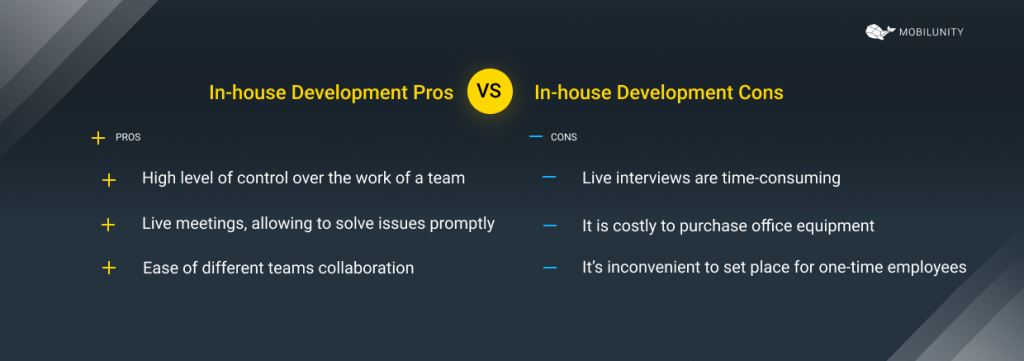Remote Insourcing vs Outsourcing: Comparison of Models

- Outsourcing vs Offshoring Definitions and Use
- History and Popularity of Working Methods
- In-House IT vs Outsourcing
- Outsourcing vs Offshoring. Main Differences
- Insourcing vs Outsourcing. Why Choose the Second Option?
- Outsourcing Use Cases
- Insourcing Use Cases
- Advantages of Insourcing and Outsourcing
- What Role Remote Work Plays into Insourcing Benefits?
- Reasons Consider Mobilunity as an Your Insourcing Company
Today, no one will be surprised by terms like outsourcing or offshoring. You do not need to be an expert in business or trade to understand what they mean. Especially if your work is somehow connected with the IT sphere. But even if you are an ordinary man in the street and are far from business, it is worth understanding not only the meaning of these words but also the difference. What is this or that tool beneficial for business? How and in what situations is it better to use it? And in the end, who should emerge victorious in the offshoring vs outsourcing fight. When comparing remote insourcing and outsourcing models, businesses should consult with recruitment consultants IT and consider the services offered by creative recruitment agencies to find the ideal talent solution for their specific needs.

Outsourcing vs Offshoring Definitions and Use
Let’s start with offshoring. As Dictionary.com tells us, this is a practice that is used by the business and consists in moving part of the business or tasks performed abroad to reduce the cost or avoid the tax burden. Another dictionary, namely, Businessdictionary.com, clarifies that such manipulations with the company are made to search for more favorable economic conditions. The same dictionary indicates that outsourcing is the transfer of a non-core business to contractors or subcontractors in order to save money, time, and other resources. That is, the professionals of other companies can take on some of the functions of a company to do a better job, faster, and cheaper. It is much easier to approach this definition of Dictionary.cambridge.org. It says that outsourcing is the payment for one company doing the work of another company. That, roughly speaking, it is. From this, it becomes clear that outsourcing vs offshoring difference lies in the location of these same experts within the country or beyond its borders and the purpose of using these tools. But let’s look at each of the terms a little deeper to understand the difference and the relevance of their application.
History and Popularity of Working Methods
Remote insourcing is gaining popularity as one of the newest trends in how businesses hire workers. Insourcing and outsourcing are not new topics to the business world. Outsourcing software development services emerged as an effective way to hire workers, while cutting costs, in the 1980s. The business strategy allows organizations to contract out major work to specialized service providers not hired as part of the internal staff. As decision makers began to understand the advantages of outsourcing, much of their employees’ workload was lifted as off-site professionals took on many of the tasks that were traditionally completed in-house. Let’s deep into a more detailed comparison of insource vs outsource.
Since the rise of outsourcing, businesses everywhere have continued to develop new methods of hiring workers. Keeping with the latest trends in society, and looking for ways to deliver the highest productivity at the lowest costs, work models have changed greatly over time. Remote work is a popular means of hiring qualified employees while saving money on infrastructure today. Given the fact that the “millennial” generation is thought to be the driving force in the popularity of remote work, many people believe that working remotely is a new concept. Remote work was initially developed in the 1970s in SoHo, New York and referred to as “live/work.”
The latest trends in remote work predict that at least half of people will be working remotely by 2020. A 2016 study performed through surveys by Gallup indicated that 43% of Americans performed all or part of their work from home. This was a jump from 2012 where the surveys indicated that only 39% of Americans worked, in some capacity, remotely.
While outsourcing has remained a popular option for businesses to reduce operating costs and open doors to additional talent, some major corporations started to shift back towards the insourcing strategy. Businesses like the successful General Electric were looking to have more control over their workers and the quality of the work they put out. In the late 2000s, they began moving from outsourcing to insourcing. Bringing work back to the states and under their control. But for businesses who didn’t have as much money to invest, still followed the pattern of outsourcing and outstaffing.
As you can see, not all companies use outsourcing as the best way to work. But such companies are comparatively very few since medium and small businesses cannot always afford to hire personnel and maintain them within the company. That is why outsourcing is gaining popularity and the tendency for more and more people to work remotely grows every year.
In-House IT vs Outsourcing
Speaking about the IT sphere, the question of in-house vs outsourcing software development will always be topical. As disputes what diet is the best in the world or what exercises are the most effective? The fact is that the approach of each company must be strictly individual. There is a certain base of truths from which you can repel and build your own scheme of interaction with employees, which will be as convenient, cheap and efficient as possible.
Let’s look at all possible inhouse development vs outsourcing pros and cons. Let’s see the benefits of having a team of professionals in-house:
- First, it is always the highest level of control over the work of a team or person in house IT vs outsourcing. His work can be not only monitored, directed or changed in the shortest possible lines but in this way, it is easiest to make all the necessary changes without any correspondence or other problems caused by remote communication.
- Secondly, it is an opportunity to initiate the main and intermediate meetings about the work, plans and any other issues.
- One more argument in house vs outsourcing pros and cons fight will be the interaction of the team that is inside your office with other employees to speed up work can significantly reduce the time to complete tasks. For example, if you have a development team that needs to cooperate with designers, copywriters, account managers, or someone else.
Among the minuses we can definitely highlight the following:
- The selection of the teams you need may take quite a long time. Indeed, for specific tasks, specific skill sets, the amount of experience and knowledge are not voidable. This gives an additional burden on the HR department and on management if it comes to the final stages of interviews.
- Purchase of equipment and furniture, rental of working space and diverse maintenance of additional personnel can be very expensive. Not to mention the fact that different types of tasks may require additional costs for software that will be used during their execution. That’s why in house development vs outsourcing is not a case for rich giant companies. They can handle everything.
- You do not always need a team of experts in the office on an ongoing basis. It often happens that you need to complete one specific project or a series of similar projects and with this, your interaction with a certain range of tasks or skills can be completed. And it is very long, expensive, and inconvenient for each such case of performing one-time tasks to be engaged in arranging a new department.
As for outsourcing, there also have their pros and cons. Let’s consider them so that you can compare and weigh the odds of the tools in the fight of the inhouse vs outsourcing.
Among the advantages of outsourcing are:
- You get a formed team of professionals and do not waste time on the selection of the skills you need to cover the implementation of all tasks.
- The team of employees hired by you is fully staffed with everything you need to start working on any of your tasks and they do not need any additional tools.
- You do not need to rent additional working space and equip comfortable workplaces for new office visitors, which makes you a whole bunch of money that can be spent on something else. For example, the performance of the main tasks of the company. And this is the main fact in outsourcing vs inhouse battle.
- You do not need to worry about whether it will be a one-time task or it will be a team for remote work on an ongoing basis. Any changes can be quickly and clearly settled by the contract or amendments to it.
- You can load employees outsourcing with all the work you need and reduce the burden on your core staff, thereby increasing the efficiency of your work in the office and completely eliminating the cost of the work of the hired team of professionals.
- Outsourcing vendor helps to improve collaboration between your teams.
And the disadvantages in outsourcing vs offshoring can be identified:
- Oursourcing team still needs regular supervision. Less control and less time to make edits due to a bit more complex communication.
- A team of professionals at outsourcing also needs to be found, and this, at times, is not so simple. If earlier it was difficult due to the small number of proposals, now it is just the opposite because of too many.
If we compare in house vs outsourcing, it becomes obvious why an absolute majority of companies choose the second option. They are willing to risk losing a small part of the control in order to save a significant amount of money, time, and to be able to get at their disposal a staffed team of professionals ready to take on any task. Small and medium-sized companies do not hire staff in the office to download only half of its work. Therefore, in house strategy in most cases works only in those companies where there are a lot of workers and some of them will be able to take on additional responsibilities, the fulfillment of tasks on new projects or something like that. If there are several dozen people in a company or it is a startup at all, and its friends create, then for its success, everyone should work around the clock and put their whole soul into the implementation of every detail of the plan. There is no one to take on additional responsibilities here. And there is almost never more money for new staff or office. So, in most cases in house IT vs outsourcing is just a question of money.
Outsourcing vs Offshoring. Main Differences
Before we move on to a more detailed overview of insourcing and outsourcing, let’s look at a couple of terms that are often confused and the meaning of which is often incomprehensible. Yes, it’s offshoring vs outsourcing difference. By definition, Oxforddictionaries.com offshoring is the placement of certain company processes abroad to reduce their cost. But how then does this term relate to outsourcing? And which one is wider? If we try to understand two different processes, then it is necessary to accurately determine their meaning and relationship. As there are terms like onshore vs offshore outsourcing we can conclude that the term outsourcing is much broader than offshoring and the first one may include the second one.
If we talk specifically about the IT field, then offshore, in fact, is a custom software development (component or system) from a company that is registered in another country. This is due to the fact that you do not want to inflate your own staff or load existing ones and you need to create a part of the program, for example, in some exotic language just for your developers.
Let’s take a look at outsourcing vs offshoring pros and cons. The advantages of offshoring and outsourcing are quite identical:
- Ready team of professionals
- Reducing the cost of work and tax burden
- Saving office space and reducing the burden on key personnel
As for the disadvantages, there are some differences in outsourcing vs offshoring:
- In some cases, you may be faced with the complex legislation of some countries and you will definitely need an experienced lawyer.
- Registration and transfer of a part of a company abroad may require much more time and money than searching for the same team of professionals within the country.
- Finding a good team outside the office is not the same as finding a good team outside the country.

Insourcing vs Outsourcing. Why Choose the Second Option?
Outsource programming is a strategic decision that has been used for years to hire third-party professionals for specific tasks or projects. The decision to outsourcing is generally based on the lack of resources a company has in-house. Local talent, skills of professionals, and availability of experts are all reasons why a company might outsource. But, one of the most gratifying advantages of outsourcing is its cost efficiency. Outsourcing has long been a means to get the right people to complete a project or task.
Opposite of outstaffing, hiring dedicated teams, or remote insourcing, most outsourcing is focused on project-based work. Although remote insourcing has become a means of hiring that many businesses are shifting towards, outsourcing is expected to remain on the upwards spectrum in the future. That’s because businesses and projects based on product development, sales, and marketing continue to see the benefits of the work model.
When looking to find the best model for your business, it’s important to compare all your options. The following table is a comparison of insourcing vs outsourcing pros and cons:
It is easy to see the differences between remote insourcing and outsourcing. The best option for your business may not be the right option for another business. Since there are many options when it comes to choosing a working model, it’s best to look at all the pros and cons of each. Although remote insourcing is its own work model, there are many elements of simple insourcing that help make the decision to choose this model obviously. There are many forms of remote work, and most businesses can customize their remote work to fit there needs. So, for many businesses, looking at the pros and cons of insourcing vs outsourcing helps to make the decision clear.
Outsourcing Use Cases
Global corporations, along with SMEs, are actively jumping on the outsourcing bandwagon. Take a look at how outsourcing IT resources beneficial in boosting businesses’ productivity and helps reduce hiring costs.
Basecamp
Back in the day when Basecamp was not the core business 37signals (a company behind the project) was handling, communication and development issues were an inch away from driving the tool into the ground.
As a consulting team, 37signals didn’t have the development expertise to maintain a big product. If you are wondering what are the pros and cons of outsourcing an IT team, keep in mind that Basecamp development and maintenance were fully handled by remote developers for at the beginning stages of the project.
Even now, with Basecamp as the company’s main product, the executive team keeps betting on the remote workforce, employing 50 tech professionals from over 32 countries.
GitHub
GitHub used outsourcing as a way to employ tech professionals cost-efficiently without compromising the product. The company’s case is proof of how much money can you save on IT outsourcing.
Back in 2008, the company hired its major Git expert, Scott Chacon as a remote contractor – there was no budget to offer a specialist a full-time salary. Thanks to outsourcing, GitHub managed to retain valuable talent without straining the corporate budget.
Now, GitHub has over 600 worldwide employees – Scott Chacon is the company’s CIO.
Opera
Back in 1995, when outsourcing was not as widespread in the IT sector, Opera was among the first major companies to smartly weigh the benefits vs risks of outsourcing IT services. As the business was a startup at the time, the executive team couldn’t commit to maintaining an in-house team. The development of the browser was outsourced to software developers from over 25 countries.
One of the world’s most secure and innovative messengers also outsourced development. The platform hired a Russian contractor to develop its core product. This way, the main team took advantage of the skilled talent they couldn’t find at home. As WhatsApp expanded, an outsourcing contractor was welcomed on board as the company’s CIO.
Insourcing Use Cases
IT insourcing vs outsourcing pros and cons debate is common among modern IT companies. Insourcing still has an extensive following and is commonly adopted by global corporations and local businesses alike.
Here are a few poster cases for insourcing.
1. General Motors
Back in 2013, GM announced that it’s bringing its overseas jobs back to the US. This helped the company simplify its data-sharing structure and focus on attracting fresh college graduates to work at General Motors.
2. Visa
Visa is another major player in finance and fintech that opted for insourcing. According to the company’s official statement, it sees a competitive advantage at building in-house teams, as opposed to working with contractors.
3. Bank of America
Back in 2013, Bank of America moved its outsourced projects from India to the US. The decision was mainly driven by the media backlash around the fact that the company fails to provide the home country citizens with jobs, opting for cost reduction overseas instead.
Other reasons to switch back to insourcing were the executives’ desire to have more control and oversight over the development process. IT outsourcing vs insourcing both have advantages and risks – which of the approaches is the right one depends entirely on the company’s needs.
Advantages of Insourcing and Outsourcing
Some businesses simply abide by the commitment to keep their business in-house. Others vow to find the most cost-efficient option and choose to outsource their work. For those who are open to the options available, here’s a closer look at the advantages of each.
Insourcing advantages include:
- Better monitoring of workers
- Ease of calling last-minute meetings
- Better buy-ins for employees
- Opportunity for learning and growing as a team
- Better communication
- Insider view of the inner workings of the business
- Long-term investment through the encouragement of employee growth
- Increase solidarity
The advantages of outsourcing include:
- Reduction in costs
- Online collaboration tools to post and manage projects
- Simple onboarding process
- Access to a global talent pool
- Increased business operations because of time zone factors and holiday schedules
- Guaranteed work continuation with no time down since time off isn’t a required benefit
What Role Remote Work Plays into Insourcing Benefits?
If you have chosen to insource your work between insourcing vs outsourcing, you still have options. In-house insourcing involves an employee’s physical presence in your office. If you need something from them, you can walk over to their desk and ask. With remote insourcing, you still have access to your employees, but it has limitations compared to in-house insourcing. Outsourcing and insourcing working models give you the control needed to collaborate with your team, set expectations, and monitor progress.
The benefits of remote work, however, are often too good to give up. At the top of the list of advantages, is the cost savings. The costs of outsourcing are much lower than insourcing because of many factors. With outsourcing, you will save on employee benefits costs such as paid time off and insurance. While outsourcing is a less expensive hiring option, following an outstaffing model can lead to even more savings. That’s because the outstaffing model helps save on administrative costs such as rent, utilities, and equipment. In-sourcing can be more than four times the cost of hiring an outstaffed development team. With developers making anywhere from $60-150 an hour plus paid time off and benefits, hiring IT professionals in-house is no longer the popular choice.
Reasons Consider Mobilunity as an Your Insourcing Company
While you can weigh the pros and cons, the advantages and disadvantages, the costs and savings, at some point you need to decide which model is best for your company. Based on the data, it’s safe to say that remote insourcing has an advantage to outsourcing. You still get the costs savings that make outsourcing so appealing. But, you also get more control, better security, and a long-term working relationship that can be of great benefit to your business.
At Mobilunity, our dedicated development teams offer all the advantages of the remote insourcing model for your information technology needs. When you work with our developers, you’ll get:
- Expert professionals at your fingertips
- High-quality work at lowered costs
- Transparent work processes
- Collaboration and timely updates
- Complete focus and dedication to your project
- On-time deliveries that meet project goals
As a decision maker, you want to deliver the best results for your business. When you combine remote insourcing with a team of professionals you can trust, the sky is not the limit when it comes to your business growth.
Boost your business with effective insourcing vs outsourcing solutions!
Disclaimer: All salaries and prices mentioned within the article are approximate numbers based on the research done by our in-house Marketing Research Team. Please use these numbers as a reference for comparison only. Feel free to use the contact form to inquire on the specific cost of the talent according to your vacancy requirements and chosen model of engagement.























